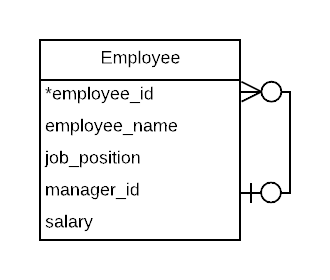In our previous post, we did not discuss Self Referencing Foreign Key while talking about Foreign Key in MySQL. So let’s see what actually is self-referencing Foreign Key in MySQL and why it is used?
what is Self Referencing Foreign Key?
Sometimes Foreign Key of a table references back to the primary key of the same table. In that case, the Foreign Key is said to be self-referencing.
Example:

In this table, the ’employee_id’ column is the primary key and the ‘manager_id’ is the foreign key.
Each employee reports to their manager who is also an employee of the same company.
Hence instead of creating a separate table for managers, we can make use of the self-referencing foreign key to define the relationship between an employee and manager on the same table.
These are some of the prominent properties of the MySQL self-referencing foreign key constraint
- Self Referencing Foreign Key is also known as Recursive Foreign Key.
- It defines the relationship between the same entity or table.
- and all others properties of normal foreign key constraint in MySQL.
Create a Table with Self Referencing Foreign Key
The general syntax to create a new table with self-referencing foreign key is
CREATE TABLE [IF NOT EXISTS] table_name(
column_1_definition,
column_2_definition,
...,
[CONSTRAINT constraint_name]
FOREIGN KEY (column_name, ...)
REFERENCES table_name(colunm_name,...)
[ON DELETE referential_action]
[ON UPDATE referential_action]
);Note: Syntax within square brackets [] are optional.
where,
IF NOT EXISTSensures that table would only be created if it doesn’t already exists in the MySQL database.CONSTRAINT constraint_nameis used to give name to the Foreign Key constraint. If we exclude it then MySQL automaticaly generates a name for the constraint.ON UPDATEandON DELETEare subclauses of the FOREIGN KEY clause which defines what referential action should take place in case of an UPDATE or DELETE operation on a key value in the parent table that has matching rows in the child table.referential_actioncould include CASCADE, SET NULL, RESTRICT, NO OPTION and SET DEFAULT.
Notice the referencing table name is the same as the name of the table which we are creating (i.e table_name).
Example:
CREATE TABLE employee (
employee_id int PRIMARY KEY,
employee_name varchar(30),
salary varchar(30),
manager_id int,
CONSTRAINT sr_fk_emp_man FOREIGN KEY (manager_id) REFERENCES employee(employee_id)
);
Add Self Referencing Foreign Key to an Existing Table
Similar to the earlier syntax, the general syntax to add a self-referencing foreign key to an existing table in MySQL relational database is
ALTER TABLE table_name
ADD [CONSTRAINT constraint_name]
FOREIGN KEY (column_name, ...)
REFERENCES parent_table(colunm_name,...)
[ON DELETE referential_action]
[ON UPDATE referential_action]
;where syntax inside square brackets [] is optional.
Recommended: Primary Key Constraint in MySQL
Here is the example where we are first creating the table then adding the foreign key constraint to it.
Example:
CREATE TABLE employee (
employee_id int PRIMARY KEY,
employee_name varchar(30),
salary varchar(30),
manager_id int
);
ALTER TABLE employee
ADD CONSTRAINT sr_fk_emp_man
FOREIGN KEY (manager_id)
REFERENCES employee(employee_id)
;The employee table now has a foreign key column: manager_id which refers to the primary key column: employee_id.
To insert records in these types of tables, we first insert records without the foreign key values.
INSERT INTO employee (employee_id, employee_name, salary) VALUES
(21, 'ISACC NEWTON', 732611),
(32, 'ROMEO', 329827);| employee_id | employee_name | salary | manager_id |
|---|---|---|---|
| 21 | ISACC NEWTON | 732611 | null |
| 32 | ROMEO | 329827 | null |
Then we add the foreign key to the new records by updating the manager_id field with the value of the employee_id of another record of the table.
UPDATE employee SET manager_id = 21 WHERE employee_name = 'ROMEO';| employee_id | employee_name | salary | manager_id |
|---|---|---|---|
| 21 | ISACC NEWTON | 732611 | null |
| 32 | ROMEO | 329827 | 21 |
When you add a foreign key constraint to a table using ALTER TABLE, remember to first create an index on the column(s) referenced by the foreign key.
I hope the concept of the self-referential foreign key is now clear to you. If you have any doubts or suggestions then please comment below.

How do I insert value into the table with self reference foreign key?
Answered your question in the post (updated).
How to make a self referencing table?
I want to display rows like Employee_ID, Employee_Name, Salary, Manager_Name. What is the query? Please help me…